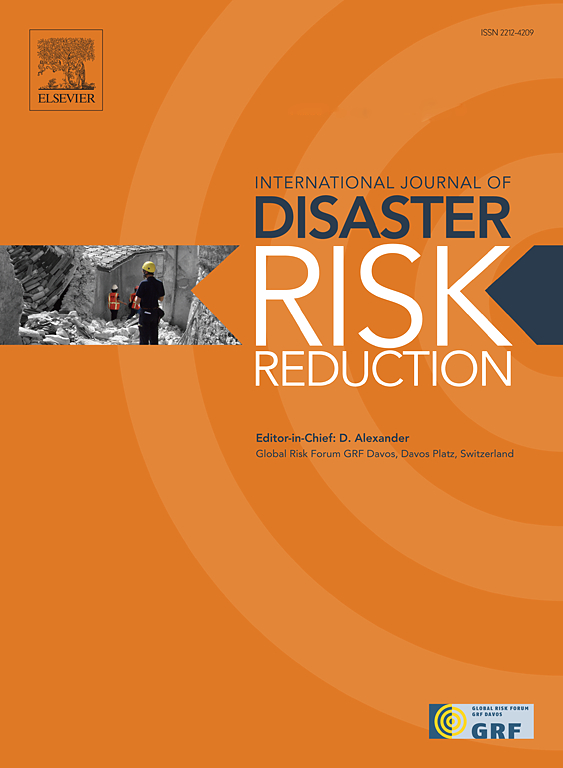城市洪水治理网络特征与适应性结构——以郑州市“7·20”特大洪水为例
IF 4.2
1区 地球科学
Q1 GEOSCIENCES, MULTIDISCIPLINARY
International journal of disaster risk reduction
Pub Date : 2025-04-06
DOI:10.1016/j.ijdrr.2025.105465
引用次数: 0
摘要
随着城市化进程的推进,洪涝灾害的复杂性和不确定性不断增加,传统的应急管理方法已无法满足人们的预期。迫切需要创造性的治理模式,以提高应急能力和治理效率。本研究将复杂适应系统(CAS)理论与社会网络分析(SNA)相结合,探讨了一种新的城市洪水管理自适应治理模型。目标是优化应急组织结构,提高应急反应的适应性。利用SNA,本研究考察了城市洪水灾害治理网络的密度和中心性,以及行动者的重要性及其发挥作用的方式。利用指数随机图模型(Exponential Random Graph Model, ERGM)对城市洪水自适应网络进行模拟,说明网络内生性和相互作用如何促进自适应网络的产生。以郑州市“7·20”特大洪涝事件为研究对象,揭示了弹性调整趋势和适应性治理过程。结果表明,内生性和交互性都会影响自适应网络的建立。具有显著内生性和高交互性的网络更有可能建立紧密的协作联系,实现信息流动,提高网络的自适应能力。在此基础上,本研究主张建立网络委员会或协作联盟,优化行动者参与,协助城市开发有效的适应性组织响应模型。本研究为明确应急网络内的组织协作关系,加强适应性联动机制提供建议。本文章由计算机程序翻译,如有差异,请以英文原文为准。
Characteristics and adaptive structure of urban flood governance network: the 'July 20th′ flooding event in Zhengzhou, China
With urbanization, the complexity and uncertainty of flood disasters have grown, rendering traditional emergency management approaches insufficient to fulfill expectations. There is an urgent need for creative governance models that improve emergency capabilities and governance effectiveness. This research investigates a novel adaptive governance model for urban flood management that combines Complex Adaptive System (CAS) theory with Social Network Analysis (SNA). The goal is to optimize the emergency organizational structure, increasing the adaptability of emergency reactions. Conducted using the SNA, this study examines the density and centrality of urban flood disaster governance network, as well as the importance of actors and how they can play a role. The Exponential Random Graph Model (ERGM) is used to simulate the urban flood adaptive network, illustrating how network endogeneity and interaction promote the generation of adaptive networks. A study is conducted on the 'July 20th′ flooding event in Zhengzhou to uncover the flexible adjustment trend and adaptive governance process. The results show that endogeneity and interactivity both influence the establishment of adaptive networks. Networks with significant endogeneity and high interactivity are more likely to build tight collaborative links and enable information flow, increasing the network's adaptive capability. Based on these findings, the study advocates the formation of network committees or collaborative alliances to optimize actor participation and assist cities in developing effective adaptive organizational response models. This study offers suggestions for clarifying organizational collaboration ties within emergency networks and strengthening adaptive linkage mechanisms.
求助全文
通过发布文献求助,成功后即可免费获取论文全文。
去求助
来源期刊

International journal of disaster risk reduction
GEOSCIENCES, MULTIDISCIPLINARYMETEOROLOGY-METEOROLOGY & ATMOSPHERIC SCIENCES
CiteScore
8.70
自引率
18.00%
发文量
688
审稿时长
79 days
期刊介绍:
The International Journal of Disaster Risk Reduction (IJDRR) is the journal for researchers, policymakers and practitioners across diverse disciplines: earth sciences and their implications; environmental sciences; engineering; urban studies; geography; and the social sciences. IJDRR publishes fundamental and applied research, critical reviews, policy papers and case studies with a particular focus on multi-disciplinary research that aims to reduce the impact of natural, technological, social and intentional disasters. IJDRR stimulates exchange of ideas and knowledge transfer on disaster research, mitigation, adaptation, prevention and risk reduction at all geographical scales: local, national and international.
Key topics:-
-multifaceted disaster and cascading disasters
-the development of disaster risk reduction strategies and techniques
-discussion and development of effective warning and educational systems for risk management at all levels
-disasters associated with climate change
-vulnerability analysis and vulnerability trends
-emerging risks
-resilience against disasters.
The journal particularly encourages papers that approach risk from a multi-disciplinary perspective.
 求助内容:
求助内容: 应助结果提醒方式:
应助结果提醒方式:


